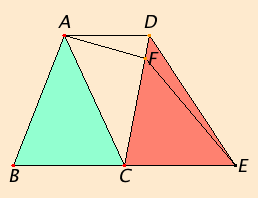Proposition 40
Let ABC and CDE be equal triangles on equal bases BC and CE and on the same side.

I say that they are also in the same parallels.
Join AD. I say that AD is parallel to BE.
If not, draw AF through A parallel to BE, and join FE.
Therefore the triangle ABC equals the triangle FCE, for they are on equal bases BC and CE and in the same parallels BE and AF.
But the triangle ABC equals the triangle DCE, therefore the triangle DCE also equals the triangle FCE, the greater equals the less, which is impossible. Therefore AF is not parallel to BE.
Similarly we can prove that neither is any other straight line except AD, therefore AD is parallel to BE.
Therefore equal triangles which are on equal bases and on the same side are also in the same parallels.